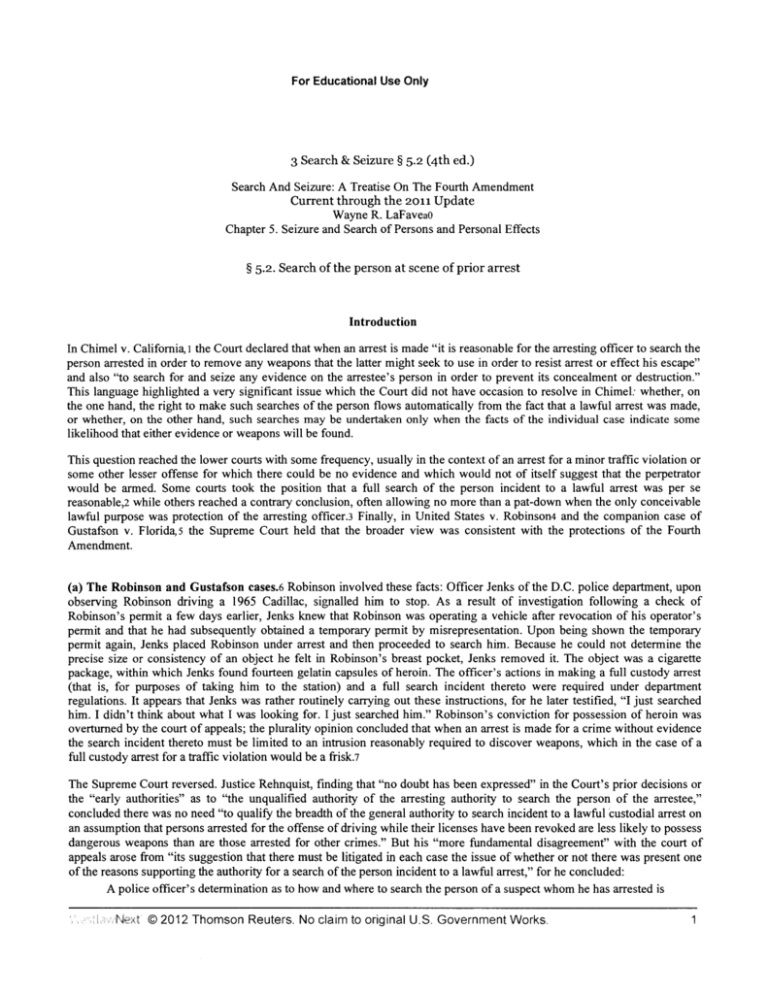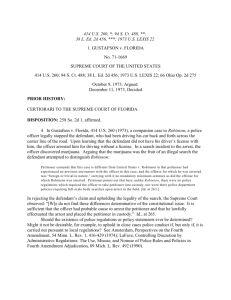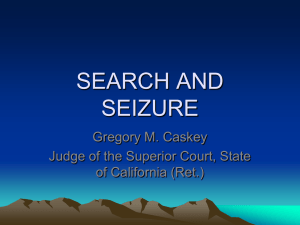3 Search & Seizure § 5.2 (4th ed.)
advertisement

For Educational Use Only 3 Search & Seizure § 5.2 (4th ed.) Search And Seizure: A Treatise On The Fourth Amendment Current through the 2011 Update Wayne R. LaFaveaO Chapter 5. Seizure and Search of Persons and Personal Effects § 5.2. Search of the person at scene of prior arrest Introduction In Chime! v. California, 1 the Court declared that when an arrest is made "it is reasonable for the arresting officer to search the person arrested in order to remove any weapons that the latter might seek to use in order to resist arrest or effect his escape" and also "to search for and seize any evidence on the arrestee's person in order to prevent its concealment or destruction." This language highlighted a very significant issue which the Court did not have occasion to resolve in Chime!: whether, on the one hand, the right to make such searches of the person flows automatically from the fact that a lawful arrest was made, or whether, on the other hand, such searches may be undertaken only when the facts of the individual case indicate some likelihood that either evidence or weapons will be found. This question reached the lower courts with some frequency, usually in the context of an arrest for a minor traffic violation or some other lesser offense for which there could be no evidence and which would not of itself suggest that the perpetrator would be armed. Some courts took the position that a full search of the person incident to a lawful arrest was per se reasonable,2 while others reached a contrary conclusion, often allowing no more than a pat-down when the only conceivable lawful purpose was protection of the arresting officer.3 Finally, in United States v. Robinson4 and the companion case of Gustafson v. Florida,s the Supreme Court held that the broader view was consistent with the protections of the Fourth Amendment. (a) The Robinson and Gustafson cases.6 Robinson involved these facts: Officer Jenks of the D.C. police department, upon observing Robinson driving a 1965 Cadillac, signalled him to stop. As a result of investigation following a check of Robinson's permit a few days earlier, Jenks knew that Robinson was operating a vehicle after revocation of his operator's permit and that he had subsequently obtained a temporary permit by misrepresentation. Upon being shown the temporary permit again, Jenks placed Robinson under arrest and then proceeded to search him. Because he could not determine the precise size or consistency of an object he felt in Robinson's breast pocket, Jenks removed it. The object was a cigarette package, within which Jenks found fourteen gelatin capsules of heroin. The officer's actions in making a full custody arrest (that is, for purposes of taking him to the station) and a full search incident thereto were required under department regulations. It appears that Jenks was rather routinely carrying out these instructions, for he later testified, "I just searched him. I didn't think about what I was looking for. I just searched him." Robinson's conviction for possession of heroin was overturned by the court of appeals; the plurality opinion concluded that when an arrest is made for a crime without evidence the search incident thereto must be limited to an intrusion reasonably required to discover weapons, which in the case of a full custody arrest for a traffic violation would be a frisk.7 The Supreme Court reversed. Justice Rehnquist, finding that "no doubt has been expressed" in the Court's prior decisions or the "early authorities" as to "the unqualified authority of the arresting authority to search the person of the arrestee," concluded there was no need "to qualifY the breadth of the general authority to search incident to a lawful custodial arrest on an assumption that persons arrested for the offense of driving while their licenses have been revoked are less likely to possess dangerous weapons than are those arrested for other crimes." But his "more fundamental disagreement" with the court of appeals arose from "its suggestion that there must be litigated in each case the issue of whether or not there was present one of the reasons supporting the authority for a search of the person incident to a lawful arrest," for he concluded: A police officer's determination as to how and where to search the person of a suspect whom he has arrested is Ne:;l: © 2012 Thomson Reuters. No claim to original U.S. Government Works. For Educational Use Only necessarily a quick ad hoc judgment which the Fourth Amendment does not require to be broken down in each instance into an analysis of each step in the search. The authority to search the person incident to a lawful custodial arrest, while based upon the need to disarm and to discover evidence, does not depend on what a court may later decide was the probability in a particular arrest situation that weapons or evidence would in fact be found upon the person of the suspect. A custodial arrest of a suspect based on probable cause is a reasonable intrusion under the Fourth Amendment; that intrusion being lawful, a search incident to the arrest requires no additional justification. It is the fact of the lawful arrest which establishes the authority to search, and we hold that in the case of a lawful custodial arrest& a full search of the person is not only an exception to the warrant requirement of the Fourth Amendment, but is also a "reasonable" search under that Amendment. Justice Marshall, joined by Justices Douglas and Brennan, dissented. Criticizing the majority's approach as "a clear and marked departure from our long tradition of case-by-case adjudication of the reasonableness of searches and seizures under the Fourth Amendment," they proceeded to assess the reasonableness of Jenks' conduct. They concluded that he acted improperly in opening the cigarette package, in that "there is no indication that he had reason to believe or did in fact believe that the package contained a weapon" and in any event "it would have been impossible for respondent to have used [a weapon therein] once the package was in the officer's hands." The facts in Gustafson were similar. . . . Robinson and Gustafson have had a significant impact. They are very frequently cited by lower courts in upholding full searches incident to a custodial arrest. II Most noteworthy, however, is the fact that some of the state courts which had previously taken a narrower view of the authority to search the person incident to arrest have accepted the Robinson-Gustafson position, either on the ground that their earlier interpretation of the requirements of the Fourth Amendment has now been established as erroneous or on the ground that their earlier interpretation of comparable state constitutional provisions should be brought into line with the interpretation the Supreme Court has given to the Fourth Amendment.l2 But a few state courts have rejected Robinson and Gustafson and construed a state constitutional provision more narrowly.13 Westlaw. © 2011 Thomson Reuters. No Claim to Orig. U.S. Govt. Works. Footnotes aO David C. Baum Professor Of Law Emeritus, And Professor Emeritus In The Center For Advanced Study, The University Of Illinois. Chime! v. California, 395 U.S. 752,89 S.Ct. 2034,23 L.Ed.2d 685 (1969). 2 E.g., United States v. Simmons, 302 A.2d 728 (D.C.App.l973); State v. Giragosian, 107 R.I. 657, 270 A.2d 921 (1970); State v. Coles, 20 Ohio Misc. 12, 249 N.E.2d 553 (1969); Watts v. State, 196 So.2d 79 (Miss.1967); Lane v. State, 424 S.W.2d 925 (Tex.Crim.App.1967). 3 E.g., People v. West, 31 Cal.App.3d 175, 107 Cal.Rptr. 127 (1973); People v. Jordan, 11 Ill.App.3d 482, 297 N.E.2d 273 (1973); State v. Curtis, 290 Minn. 429, 190 N.W.2d 631 (1971); People v. Adams, 32 N.Y.2d 451, 346 N.Y.S.2d 229, 299 N.E.2d 653 (1973); Commonwealth v. Freeman, 222 Pa.Super. 178, 293 A.2d 84 (1972). Other decisions taking this more limited view are collected in United States v. Robinson, 471 F.2d 1082, 1104 n. 39 (D.C.Cir.1972). 4 United States v. Robinson, 414 U.S. 218, 94 S.Ct. 467, 38 L.Ed.2d 427 (1973). 5 Gustafson v. Florida, 414 U.S. 260, 94 S.Ct. 488, 38 L.Ed.2d 456 (1973). 6 Much of what is said in the discussion which follows in this section first appeared in LaFave, "Case by Case Adjudication" Versus "Standardized Procedures": The Robinson Dilemma, 1974 Sup.Ct.Rev. 127. See also Aaronson & Wallace, A Reconsideration of the Fourth Amendment's Doctrine of Search Incident to Arrest, 64 Geo.L.J. 53 (1975); White, The Fourth Amendment as a Way of Talking About People: A Study of Robinson and Matlock, 1974 Sup.Ct.Rev. 165; Comments, 24 Emory L.J. 151 (1975); 63 Geo.L.J. 223 (1974); Notes, 23 Clev.St.L.Rev. 135 (1974); 7 Loy.L.A.L.Rev. 516 (1974); 1 Ohio N.L.Rev. 334 (1974); 7 Sw.U.L.Rev. 383 (1975). 7 The case was heard initially by a division of the court of appeals, which reversed the conviction, but upon rehearing en bane the case was remanded for a supplemental evidentiary hearing. 447 F.2d 1215 (D.C.Cir.1971 ). Upon the subsequent rehearing en bane, Ne:<t © 2012 Thomson Reuters. No claim to original U.S. Government Works. 2 For Educational Use Only 471 F.2d 1082 (D.C.Cir.1972), the plurality opinion was written by Judge Wright. Chief Judge Bazelon wrote a brief concurring opinion; Judge Wilkey, joined by three other members of the court, dissented. 8 While this phrase has sometimes been taken to mean "lawful" in the sense that the law of the jurisdiction where the arrest occurs does not require a noncustodial alternative, e.g., United States v. Mota, 982 F.2d 1384 (9th Cir.1993), the Supreme Court rejected that position in Virginia v. Moore,_ U.S._, 128 S.Ct. 1598, 170 L.Ed.2d 559 (2008). See § 1.5, text at note 81.1. 9 258 So.2d 1 (Fla.1972), reversing 243 So.2d 615 (Fla.App.1971). IO See text at note 140 infra. II A particularly useful example of the impact of the Robinson-Gustafson rule is provided by People v. Traubert, 199 Colo. 322, 608 P.2d 342 (1980), where defendant was searched following his arrest for trying to break into a building. Defendant claimed there was no justification for the search in that there were no fruits (he had not gotten into the building), instrumentalities (the burglary tools had been found at the scene), or weapons (an unproductive frisk had already been conducted) to look for, but the court rejected the contention with the observation that under Robinson the right to search flows automatically from a lawful custodial arrest. See also People v. Bischofberger, 724 P.2d 660 (Colo.1986) (Robinson allows search of person arrested merely because of outstanding traffic warrants). In State v. Kennel, 26 Ariz.App. 147, 546 P.2d 1156 (1976), Robinson was applied to the taking of custody of an intoxicated person for the purpose of transporting him to the local alcoholic reception center. Compare United States v. Gallop, 606 F.2d 836 (9th Cir.1979), holding that when police seized abusive persons for transportation to a detoxification center, characterized by statute as protective custody and not arrest, no Robinson search was permissible. See also State v. Lawrence, 58 Or.App. 423, 648 P.2d 1332 (1982) (detention of intoxicated person permits pat-down but no full search of person); State v. Loewen, 97 Wash.2d 562, 647 P.2d 489 (1982) (full search not allowed incident to transporting of disoriented and injured person to hospital). I2 People v. Weintraub, 35 N.Y.2d 351, 361 N.Y.S.2d 897, 320 N.E.2d 636 (1974); Hughes v. State, 522 P.2d 1331 (Oki.Crim.App.1974); State v. Florance, 270 Or. 169, 527 P.2d 1202 (1974) (on ground that Robinson should now be followed in interpreting comparable state constitutional provision, as that case presents a rule which will be better understood by police and confusion between federal and state rules is to be avoided). I3 Middleton v. State, 577 P.2d 1050 (Alaska 1978); People v. Maher, 17 Cal.3d 196, 130 Cai.Rptr. 508,550 P.2d 1044 (1976); State v. Rosborough, 62 Haw. 238, 615 P.2d 84 (1980); State v. Dangerfield, 171 N.J. 446, 795 A.2d 250 (2002); State v. Paul T., 128 N.M. 360, 993 P.2d 74 (1999). State v. Neil, 184 Vt. 243, 958 A.2d 1173 (2008). End of Document ~Je\t © 2012 Thomson Reuters. No claim to original U.S. Government Works. © 2012 Thomson Reuters. No claim to original U.S. Government Works. 3







